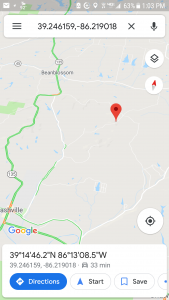South Central Chapter Hike in Lilly-Dickey Woods, October 26
Walk in the Woods with South Central Chapter
October 26, 2019
Lilly-Dickey Woods, IU Research and Teaching Preserve
3100 Bear Wallow Hill Rd
Brown County
Led by Gillian Harris and Mark Sheehan
1:00-4:00 p.m.
Register by emailing southcentral@indiananativeplants.org. Limited to 20 participants.
Directions: Coordinates are: 39.246159,-86.219018
From Nashville, take Main Street east from the center of town. At the bottom of the first hill, take Greasy Creek Rd north to Bear Wallow Hill Rd. Continue north on Bear Wallow Hill Rd to the parking area on the right. If you get to Freeman Ridge Rd, you’ve gone too far north.
From Bean Blossom, turn east at the intersection of Indiana 135 and Gatesville Rd. Follow Gatesville Rd to its intersection with Bear Wallow Rd. Turn south on Bear Wallow Hill Rd and follow it to Freeman Ridge Rd. From that intersection continue slowly south on Bear Wallow Hill Rd until you come to the parking area on the left.

Description
Lilly-Dickey Woods is one of the nine properties that make up the Indiana University Research and Teaching Preserve. It is the largest of those properties, at 550 acres. It is located 3.5 miles north of Nashville, IN. Substantial properties to the north and east are owned by The Nature Conservancy.
In 1942 Lilly-Dickey Woods was donated to IU by Josiah Lilly, grandson of pharmaceutical magnate Eli Lilly, and Marcus Dickey, who had been secretary and biographer to poet James Whitcomb Riley and was a friend of painter T.C. Steele. The property transfer documents stipulated that IU use the land for artistic and scientific purposes.
Our hike will take us through the Lilly property and past a forest fire lookout tower erected around 1930. The tower is still structurally sound but for safety reasons will be off limits to us.
The largest trees on the property are around 150 years old. The forest canopy includes black, white, red, scarlet, and chestnut oaks, pignut and shagbark hickories, sugar and red maples, American beech, American basswood, slippery elm, tulip poplar, and several other species. American ash was a significant component of the canopy before the invasion of the emerald ash borer; only a few individuals survive now. The understory of the forest includes spicebush, leatherwood, and pawpaw. Roundleaf greenbriar is thick on the ridgetops and south-facing slopes. Tussocks of painted sedge dot the forest floor.
In 2012, researchers from IU inventoried the trees in a 62-acre square toward the southern edge of the property as part of the Smithsonian Institution’s Global Earth Observatory project. Every tree greater than one centimeter in diameter at breast height was identified, measured, and mapped, providing a rare scientific resource that has attracted scholars from all over the U.S. IU repeats the inventory at five-year intervals, with the most recent one occurring in 2017. Mark Sheehan, one of our hike leaders, participated in the first inventory and led the second.
Lilly-Dickey Woods is not open to the public. Our visit is by special arrangement with the property manager.
